HA515 Leadership: Globalization, Culture, and Change in Healthcare Org
VerifiedAdded on 2023/04/21
|10
|2558
|496
Report
AI Summary
This report examines the impact of globalization and diversity on healthcare organizations, focusing on the attributes of successful health leaders and issues related to globalization, power, followership, and cultural change. It identifies major global health issues affecting the U.S. healthcare system, describes their influence on stakeholders, and relates global leadership styles to transformational leadership. The report also discusses critical elements of culture and diversity in modern healthcare, categorizes global leadership differences based on power, technology, and knowledge management, and provides two leadership approaches for implementing change: charismatic and democratic leadership. The analysis emphasizes the need for cultural awareness and adaptation in healthcare leadership to effectively manage diverse teams and patient populations.

Running head: LEADERSHIP IN HEALTHCARE 1
Leadership in Healthcare
Institution
Student
Date
Leadership in Healthcare
Institution
Student
Date
Paraphrase This Document
Need a fresh take? Get an instant paraphrase of this document with our AI Paraphraser
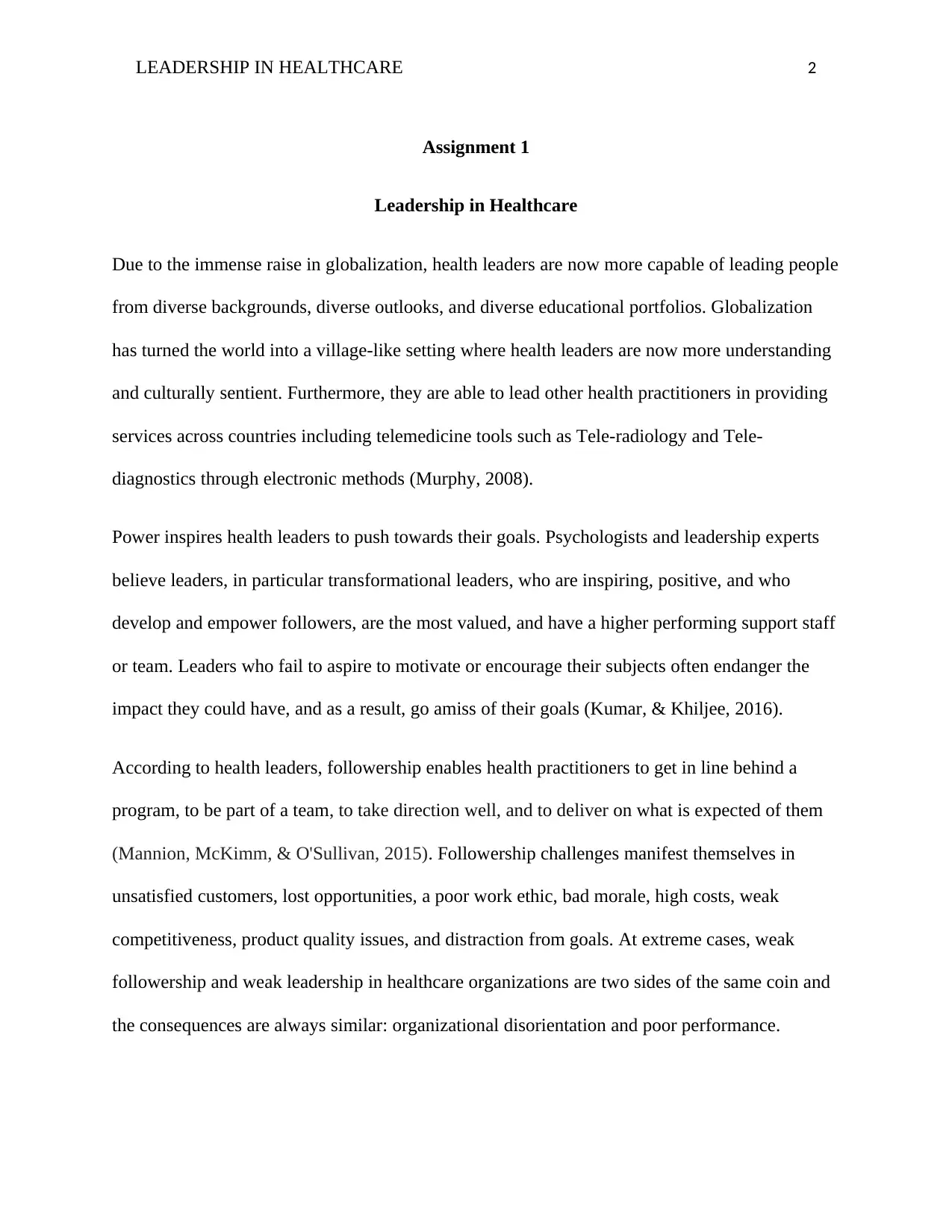
LEADERSHIP IN HEALTHCARE 2
Assignment 1
Leadership in Healthcare
Due to the immense raise in globalization, health leaders are now more capable of leading people
from diverse backgrounds, diverse outlooks, and diverse educational portfolios. Globalization
has turned the world into a village-like setting where health leaders are now more understanding
and culturally sentient. Furthermore, they are able to lead other health practitioners in providing
services across countries including telemedicine tools such as Tele-radiology and Tele-
diagnostics through electronic methods (Murphy, 2008).
Power inspires health leaders to push towards their goals. Psychologists and leadership experts
believe leaders, in particular transformational leaders, who are inspiring, positive, and who
develop and empower followers, are the most valued, and have a higher performing support staff
or team. Leaders who fail to aspire to motivate or encourage their subjects often endanger the
impact they could have, and as a result, go amiss of their goals (Kumar, & Khiljee, 2016).
According to health leaders, followership enables health practitioners to get in line behind a
program, to be part of a team, to take direction well, and to deliver on what is expected of them
(Mannion, McKimm, & O'Sullivan, 2015). Followership challenges manifest themselves in
unsatisfied customers, lost opportunities, a poor work ethic, bad morale, high costs, weak
competitiveness, product quality issues, and distraction from goals. At extreme cases, weak
followership and weak leadership in healthcare organizations are two sides of the same coin and
the consequences are always similar: organizational disorientation and poor performance.
Assignment 1
Leadership in Healthcare
Due to the immense raise in globalization, health leaders are now more capable of leading people
from diverse backgrounds, diverse outlooks, and diverse educational portfolios. Globalization
has turned the world into a village-like setting where health leaders are now more understanding
and culturally sentient. Furthermore, they are able to lead other health practitioners in providing
services across countries including telemedicine tools such as Tele-radiology and Tele-
diagnostics through electronic methods (Murphy, 2008).
Power inspires health leaders to push towards their goals. Psychologists and leadership experts
believe leaders, in particular transformational leaders, who are inspiring, positive, and who
develop and empower followers, are the most valued, and have a higher performing support staff
or team. Leaders who fail to aspire to motivate or encourage their subjects often endanger the
impact they could have, and as a result, go amiss of their goals (Kumar, & Khiljee, 2016).
According to health leaders, followership enables health practitioners to get in line behind a
program, to be part of a team, to take direction well, and to deliver on what is expected of them
(Mannion, McKimm, & O'Sullivan, 2015). Followership challenges manifest themselves in
unsatisfied customers, lost opportunities, a poor work ethic, bad morale, high costs, weak
competitiveness, product quality issues, and distraction from goals. At extreme cases, weak
followership and weak leadership in healthcare organizations are two sides of the same coin and
the consequences are always similar: organizational disorientation and poor performance.
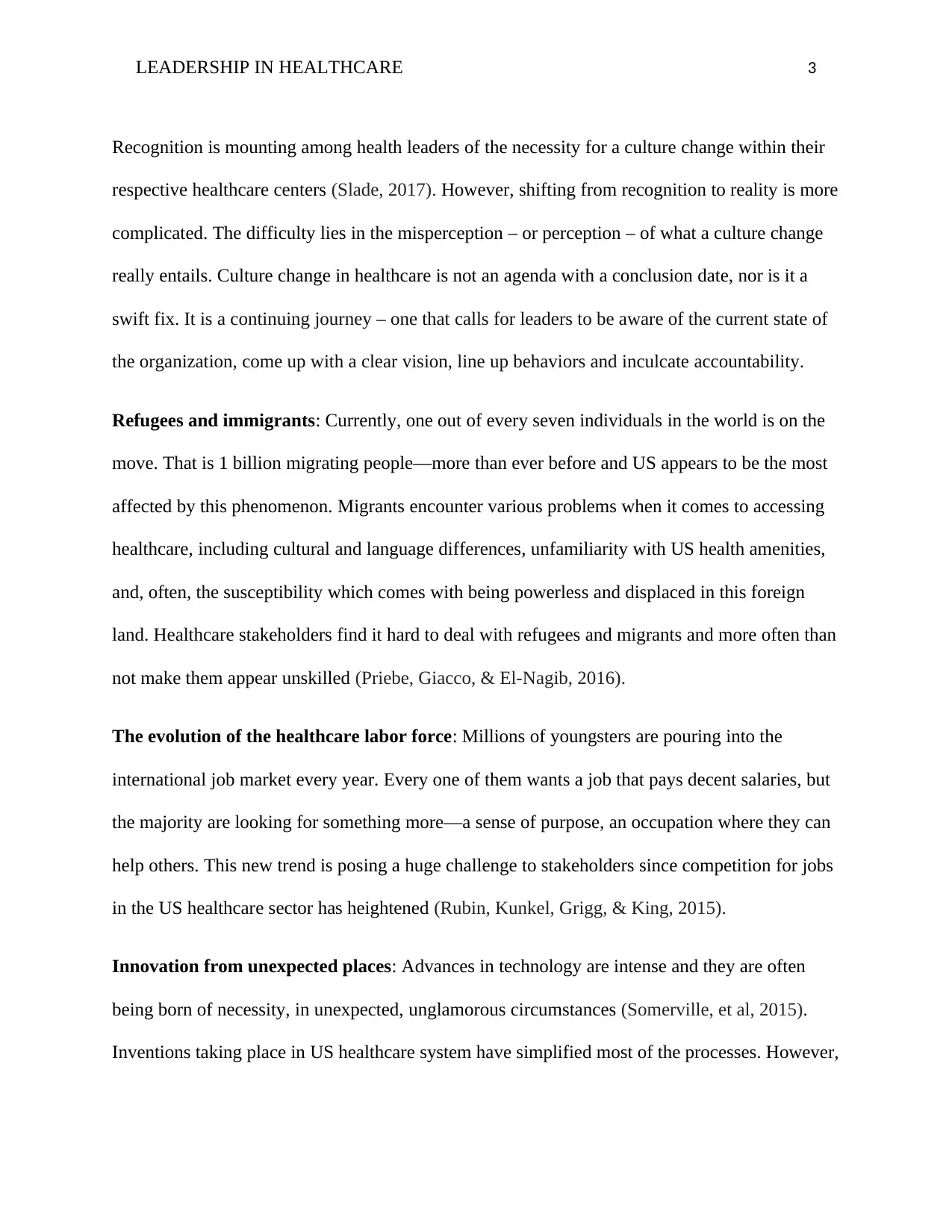
LEADERSHIP IN HEALTHCARE 3
Recognition is mounting among health leaders of the necessity for a culture change within their
respective healthcare centers (Slade, 2017). However, shifting from recognition to reality is more
complicated. The difficulty lies in the misperception – or perception – of what a culture change
really entails. Culture change in healthcare is not an agenda with a conclusion date, nor is it a
swift fix. It is a continuing journey – one that calls for leaders to be aware of the current state of
the organization, come up with a clear vision, line up behaviors and inculcate accountability.
Refugees and immigrants: Currently, one out of every seven individuals in the world is on the
move. That is 1 billion migrating people—more than ever before and US appears to be the most
affected by this phenomenon. Migrants encounter various problems when it comes to accessing
healthcare, including cultural and language differences, unfamiliarity with US health amenities,
and, often, the susceptibility which comes with being powerless and displaced in this foreign
land. Healthcare stakeholders find it hard to deal with refugees and migrants and more often than
not make them appear unskilled (Priebe, Giacco, & El-Nagib, 2016).
The evolution of the healthcare labor force: Millions of youngsters are pouring into the
international job market every year. Every one of them wants a job that pays decent salaries, but
the majority are looking for something more—a sense of purpose, an occupation where they can
help others. This new trend is posing a huge challenge to stakeholders since competition for jobs
in the US healthcare sector has heightened (Rubin, Kunkel, Grigg, & King, 2015).
Innovation from unexpected places: Advances in technology are intense and they are often
being born of necessity, in unexpected, unglamorous circumstances (Somerville, et al, 2015).
Inventions taking place in US healthcare system have simplified most of the processes. However,
Recognition is mounting among health leaders of the necessity for a culture change within their
respective healthcare centers (Slade, 2017). However, shifting from recognition to reality is more
complicated. The difficulty lies in the misperception – or perception – of what a culture change
really entails. Culture change in healthcare is not an agenda with a conclusion date, nor is it a
swift fix. It is a continuing journey – one that calls for leaders to be aware of the current state of
the organization, come up with a clear vision, line up behaviors and inculcate accountability.
Refugees and immigrants: Currently, one out of every seven individuals in the world is on the
move. That is 1 billion migrating people—more than ever before and US appears to be the most
affected by this phenomenon. Migrants encounter various problems when it comes to accessing
healthcare, including cultural and language differences, unfamiliarity with US health amenities,
and, often, the susceptibility which comes with being powerless and displaced in this foreign
land. Healthcare stakeholders find it hard to deal with refugees and migrants and more often than
not make them appear unskilled (Priebe, Giacco, & El-Nagib, 2016).
The evolution of the healthcare labor force: Millions of youngsters are pouring into the
international job market every year. Every one of them wants a job that pays decent salaries, but
the majority are looking for something more—a sense of purpose, an occupation where they can
help others. This new trend is posing a huge challenge to stakeholders since competition for jobs
in the US healthcare sector has heightened (Rubin, Kunkel, Grigg, & King, 2015).
Innovation from unexpected places: Advances in technology are intense and they are often
being born of necessity, in unexpected, unglamorous circumstances (Somerville, et al, 2015).
Inventions taking place in US healthcare system have simplified most of the processes. However,
⊘ This is a preview!⊘
Do you want full access?
Subscribe today to unlock all pages.

Trusted by 1+ million students worldwide
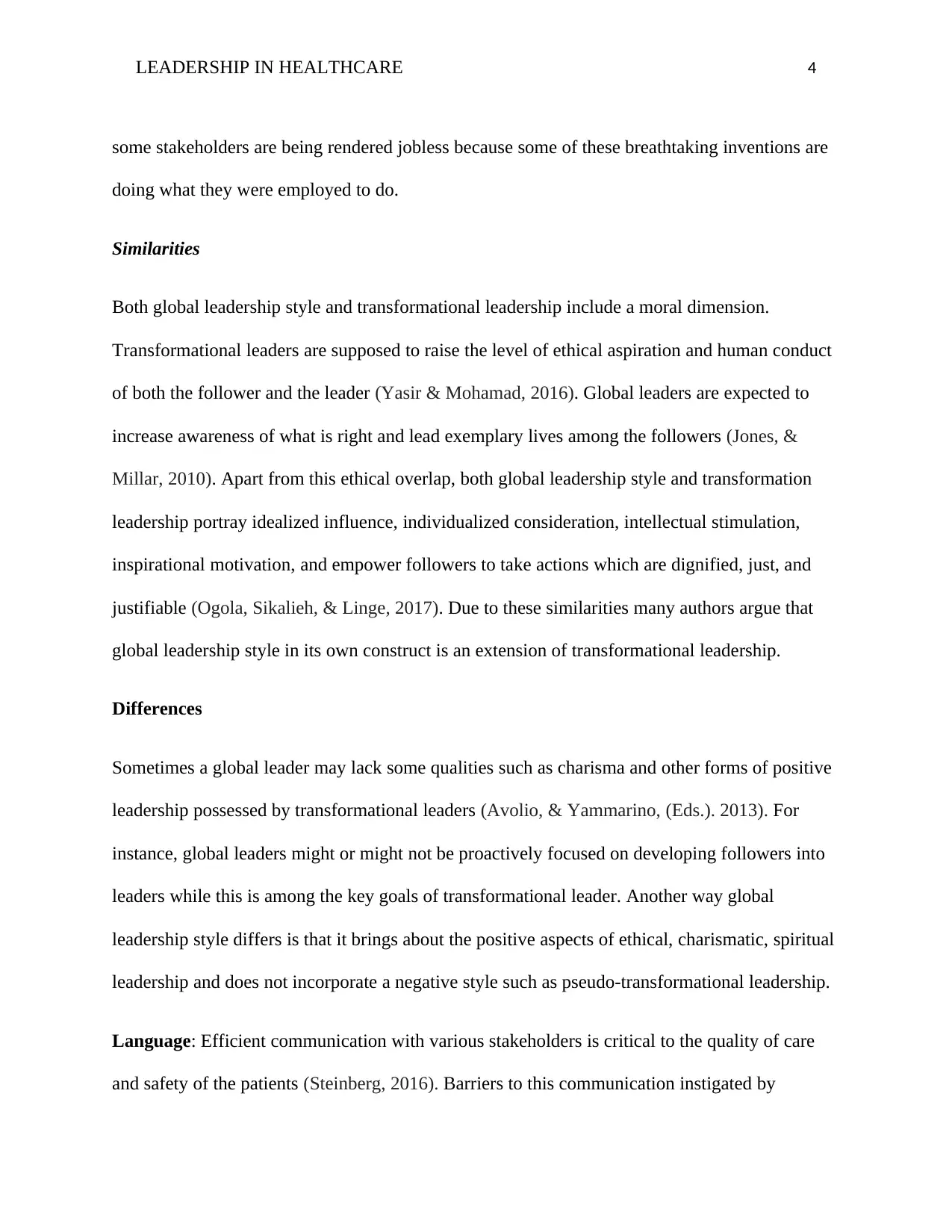
LEADERSHIP IN HEALTHCARE 4
some stakeholders are being rendered jobless because some of these breathtaking inventions are
doing what they were employed to do.
Similarities
Both global leadership style and transformational leadership include a moral dimension.
Transformational leaders are supposed to raise the level of ethical aspiration and human conduct
of both the follower and the leader (Yasir & Mohamad, 2016). Global leaders are expected to
increase awareness of what is right and lead exemplary lives among the followers (Jones, &
Millar, 2010). Apart from this ethical overlap, both global leadership style and transformation
leadership portray idealized influence, individualized consideration, intellectual stimulation,
inspirational motivation, and empower followers to take actions which are dignified, just, and
justifiable (Ogola, Sikalieh, & Linge, 2017). Due to these similarities many authors argue that
global leadership style in its own construct is an extension of transformational leadership.
Differences
Sometimes a global leader may lack some qualities such as charisma and other forms of positive
leadership possessed by transformational leaders (Avolio, & Yammarino, (Eds.). 2013). For
instance, global leaders might or might not be proactively focused on developing followers into
leaders while this is among the key goals of transformational leader. Another way global
leadership style differs is that it brings about the positive aspects of ethical, charismatic, spiritual
leadership and does not incorporate a negative style such as pseudo-transformational leadership.
Language: Efficient communication with various stakeholders is critical to the quality of care
and safety of the patients (Steinberg, 2016). Barriers to this communication instigated by
some stakeholders are being rendered jobless because some of these breathtaking inventions are
doing what they were employed to do.
Similarities
Both global leadership style and transformational leadership include a moral dimension.
Transformational leaders are supposed to raise the level of ethical aspiration and human conduct
of both the follower and the leader (Yasir & Mohamad, 2016). Global leaders are expected to
increase awareness of what is right and lead exemplary lives among the followers (Jones, &
Millar, 2010). Apart from this ethical overlap, both global leadership style and transformation
leadership portray idealized influence, individualized consideration, intellectual stimulation,
inspirational motivation, and empower followers to take actions which are dignified, just, and
justifiable (Ogola, Sikalieh, & Linge, 2017). Due to these similarities many authors argue that
global leadership style in its own construct is an extension of transformational leadership.
Differences
Sometimes a global leader may lack some qualities such as charisma and other forms of positive
leadership possessed by transformational leaders (Avolio, & Yammarino, (Eds.). 2013). For
instance, global leaders might or might not be proactively focused on developing followers into
leaders while this is among the key goals of transformational leader. Another way global
leadership style differs is that it brings about the positive aspects of ethical, charismatic, spiritual
leadership and does not incorporate a negative style such as pseudo-transformational leadership.
Language: Efficient communication with various stakeholders is critical to the quality of care
and safety of the patients (Steinberg, 2016). Barriers to this communication instigated by
Paraphrase This Document
Need a fresh take? Get an instant paraphrase of this document with our AI Paraphraser

LEADERSHIP IN HEALTHCARE 5
disparities in language, low health literacy, and cultural differences lower the effectiveness of the
modern healthcare processes. Evidence-based practices which lower these hindrances should be
incorporated into, rather than just added to, health care work processes.
Social values and norms: Ethnic customs, religion, culture beliefs often influence the way
patients take care of their health, the way they identify with health concepts, as well as the way
they make decisions related to their health. Asking about elements of culture and diversity can
help medical specialists engage patients so that, jointly, they can come up with treatment plans
which are in harmony with the patients' values (Carter, 2018).
Work ethic: Some cultures tend to have a more slipshod approach to work hours while others
have extremely stringent approaches to work hours. It is therefore splendid for managers in
healthcare organizations to take this element into consideration when dealing with people from
diverse backgrounds (Mustafa, Lulin, Abdullahi, & Nisar, 2017).
Some of the cultural attributes to be cognizant of include:
Communication
Trust/Integrity
Respect/ Fairness
Teamwork
Results Orientation
Decision Making
Results Orientation
Meaning/Purpose
disparities in language, low health literacy, and cultural differences lower the effectiveness of the
modern healthcare processes. Evidence-based practices which lower these hindrances should be
incorporated into, rather than just added to, health care work processes.
Social values and norms: Ethnic customs, religion, culture beliefs often influence the way
patients take care of their health, the way they identify with health concepts, as well as the way
they make decisions related to their health. Asking about elements of culture and diversity can
help medical specialists engage patients so that, jointly, they can come up with treatment plans
which are in harmony with the patients' values (Carter, 2018).
Work ethic: Some cultures tend to have a more slipshod approach to work hours while others
have extremely stringent approaches to work hours. It is therefore splendid for managers in
healthcare organizations to take this element into consideration when dealing with people from
diverse backgrounds (Mustafa, Lulin, Abdullahi, & Nisar, 2017).
Some of the cultural attributes to be cognizant of include:
Communication
Trust/Integrity
Respect/ Fairness
Teamwork
Results Orientation
Decision Making
Results Orientation
Meaning/Purpose

LEADERSHIP IN HEALTHCARE 6
Goals/Strategy.
Some global healthcare leaders use the power bestowed on them to empower followers, they
anticipate for a better world, and comprehend the setbacks of oppression (MacPhee, Chang, Lee,
& Spiri, 2013). A great leader’s vision is to influence and empower people, to fight oppression,
and to bring about change. Other leaders, however, use their power to oppress and create a
system that discriminates against some groups and benefit others.
Some class of global leaders uses technology to improve themselves as leaders. They for
instance use online opportunities to train and communicate with their followers and patients and
the process enhance their leadership practices (Patterson et al, 2016). Some use social media
platforms such as Facebook, LinkedIn, and Twitter to maintain their presence and socialize with
various stakeholders (Halevi, Liu, & Yoon, 2018). However, some global leaders use technology
negatively by for instance abusing power. They sometimes use patient confidential information
for their selfish benefits.
Global leader have a vital role in the process оf knowledge management. In order to be
successful, some of them acquire skills and qualities which they then use to craft the conditions
for creating, transferring and using knowledge in organizations (Farkas, 2003). Nevertheless,
apart from taking part in the creation, sharing and use of knowledge, some global leaders
promote and create new knowledge that contributes to creating value for their respective
healthcare organization. Different leaders take different roles in the creation and use of
knowledge management.
Provide at least two leadership approaches for implementing change.
Goals/Strategy.
Some global healthcare leaders use the power bestowed on them to empower followers, they
anticipate for a better world, and comprehend the setbacks of oppression (MacPhee, Chang, Lee,
& Spiri, 2013). A great leader’s vision is to influence and empower people, to fight oppression,
and to bring about change. Other leaders, however, use their power to oppress and create a
system that discriminates against some groups and benefit others.
Some class of global leaders uses technology to improve themselves as leaders. They for
instance use online opportunities to train and communicate with their followers and patients and
the process enhance their leadership practices (Patterson et al, 2016). Some use social media
platforms such as Facebook, LinkedIn, and Twitter to maintain their presence and socialize with
various stakeholders (Halevi, Liu, & Yoon, 2018). However, some global leaders use technology
negatively by for instance abusing power. They sometimes use patient confidential information
for their selfish benefits.
Global leader have a vital role in the process оf knowledge management. In order to be
successful, some of them acquire skills and qualities which they then use to craft the conditions
for creating, transferring and using knowledge in organizations (Farkas, 2003). Nevertheless,
apart from taking part in the creation, sharing and use of knowledge, some global leaders
promote and create new knowledge that contributes to creating value for their respective
healthcare organization. Different leaders take different roles in the creation and use of
knowledge management.
Provide at least two leadership approaches for implementing change.
⊘ This is a preview!⊘
Do you want full access?
Subscribe today to unlock all pages.

Trusted by 1+ million students worldwide

LEADERSHIP IN HEALTHCARE 7
Charismatic leadership: Leaders in healthcare organizations can navigate change by
encouraging certain behaviors in others by way of persuasion, expressive communication, and
force of personality (Allen, Moore, Moser, Neill, Sambamoorthi, & Bell, 2016). It is
recommendable approach of bringing in change by motivating followers to get things done or
improving the way particular things are done.
Democratic leadership: Leaders can navigate changes by allowing every stakeholder to take an
active role in the decision-making process (Swensen, Gorringe, Caviness, & Peters, 2016).
References
Allen, G. P., Moore, W. M., Moser, L. R., Neill, K. K., Sambamoorthi, U., & Bell, H. S. (2016).
The role of servant leadership and transformational leadership in academic
pharmacy. American journal of pharmaceutical education, 80(7), 113.
Avolio, B. J., & Yammarino, F. J. (Eds.). (2013). Introduction to, and overview of,
transformational and charismatic leadership. In Transformational and Charismatic
Leadership: The Road Ahead 10th Anniversary Edition (pp. xxvii-xxxiii). Emerald Group
Publishing Limited.
Carter, S. M. (2018). Valuing Healthcare Improvement: Implicit Norms, Explicit Normativity,
and Human Agency. Health Care Analysis, 26(2), 189-205.
Charismatic leadership: Leaders in healthcare organizations can navigate change by
encouraging certain behaviors in others by way of persuasion, expressive communication, and
force of personality (Allen, Moore, Moser, Neill, Sambamoorthi, & Bell, 2016). It is
recommendable approach of bringing in change by motivating followers to get things done or
improving the way particular things are done.
Democratic leadership: Leaders can navigate changes by allowing every stakeholder to take an
active role in the decision-making process (Swensen, Gorringe, Caviness, & Peters, 2016).
References
Allen, G. P., Moore, W. M., Moser, L. R., Neill, K. K., Sambamoorthi, U., & Bell, H. S. (2016).
The role of servant leadership and transformational leadership in academic
pharmacy. American journal of pharmaceutical education, 80(7), 113.
Avolio, B. J., & Yammarino, F. J. (Eds.). (2013). Introduction to, and overview of,
transformational and charismatic leadership. In Transformational and Charismatic
Leadership: The Road Ahead 10th Anniversary Edition (pp. xxvii-xxxiii). Emerald Group
Publishing Limited.
Carter, S. M. (2018). Valuing Healthcare Improvement: Implicit Norms, Explicit Normativity,
and Human Agency. Health Care Analysis, 26(2), 189-205.
Paraphrase This Document
Need a fresh take? Get an instant paraphrase of this document with our AI Paraphraser
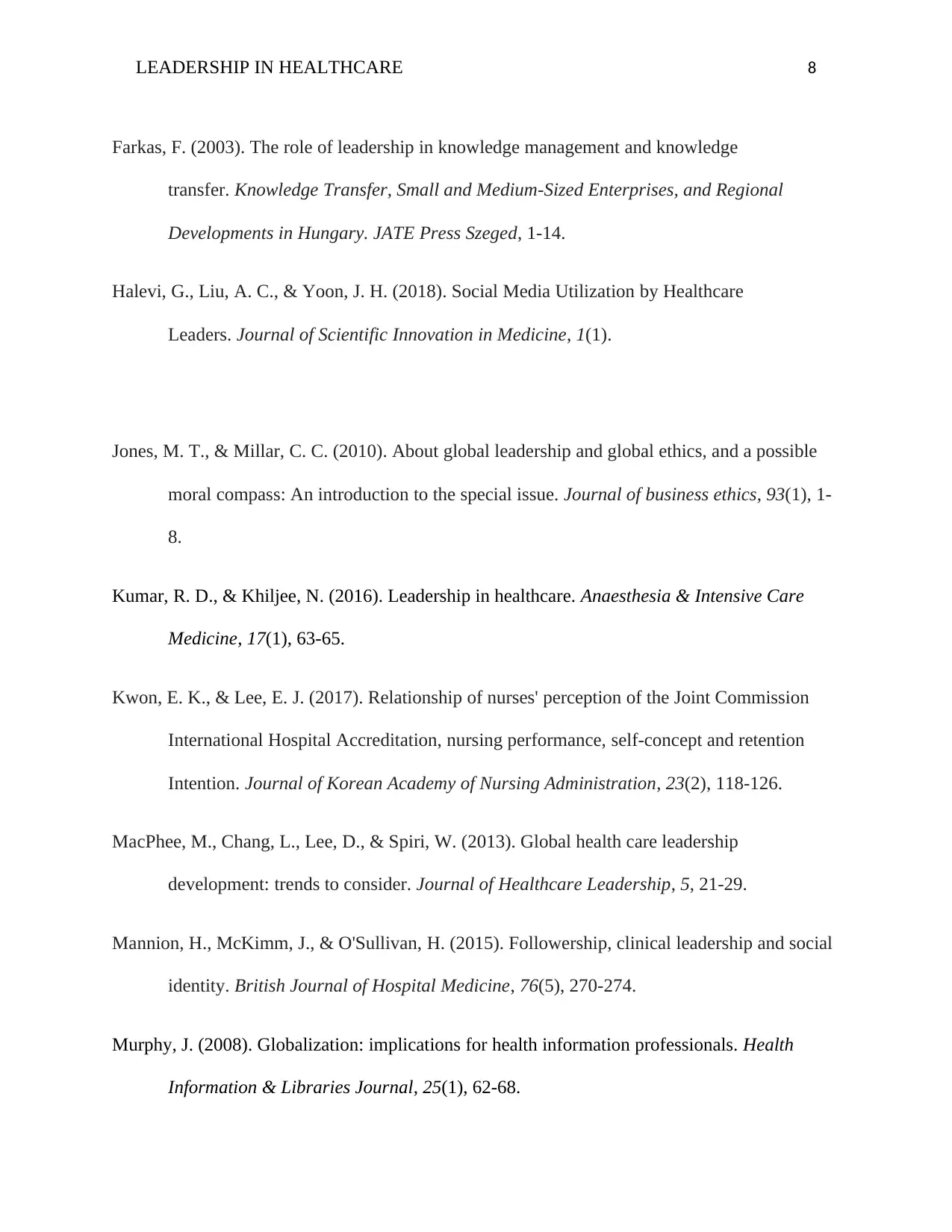
LEADERSHIP IN HEALTHCARE 8
Farkas, F. (2003). The role of leadership in knowledge management and knowledge
transfer. Knowledge Transfer, Small and Medium-Sized Enterprises, and Regional
Developments in Hungary. JATE Press Szeged, 1-14.
Halevi, G., Liu, A. C., & Yoon, J. H. (2018). Social Media Utilization by Healthcare
Leaders. Journal of Scientific Innovation in Medicine, 1(1).
Jones, M. T., & Millar, C. C. (2010). About global leadership and global ethics, and a possible
moral compass: An introduction to the special issue. Journal of business ethics, 93(1), 1-
8.
Kumar, R. D., & Khiljee, N. (2016). Leadership in healthcare. Anaesthesia & Intensive Care
Medicine, 17(1), 63-65.
Kwon, E. K., & Lee, E. J. (2017). Relationship of nurses' perception of the Joint Commission
International Hospital Accreditation, nursing performance, self-concept and retention
Intention. Journal of Korean Academy of Nursing Administration, 23(2), 118-126.
MacPhee, M., Chang, L., Lee, D., & Spiri, W. (2013). Global health care leadership
development: trends to consider. Journal of Healthcare Leadership, 5, 21-29.
Mannion, H., McKimm, J., & O'Sullivan, H. (2015). Followership, clinical leadership and social
identity. British Journal of Hospital Medicine, 76(5), 270-274.
Murphy, J. (2008). Globalization: implications for health information professionals. Health
Information & Libraries Journal, 25(1), 62-68.
Farkas, F. (2003). The role of leadership in knowledge management and knowledge
transfer. Knowledge Transfer, Small and Medium-Sized Enterprises, and Regional
Developments in Hungary. JATE Press Szeged, 1-14.
Halevi, G., Liu, A. C., & Yoon, J. H. (2018). Social Media Utilization by Healthcare
Leaders. Journal of Scientific Innovation in Medicine, 1(1).
Jones, M. T., & Millar, C. C. (2010). About global leadership and global ethics, and a possible
moral compass: An introduction to the special issue. Journal of business ethics, 93(1), 1-
8.
Kumar, R. D., & Khiljee, N. (2016). Leadership in healthcare. Anaesthesia & Intensive Care
Medicine, 17(1), 63-65.
Kwon, E. K., & Lee, E. J. (2017). Relationship of nurses' perception of the Joint Commission
International Hospital Accreditation, nursing performance, self-concept and retention
Intention. Journal of Korean Academy of Nursing Administration, 23(2), 118-126.
MacPhee, M., Chang, L., Lee, D., & Spiri, W. (2013). Global health care leadership
development: trends to consider. Journal of Healthcare Leadership, 5, 21-29.
Mannion, H., McKimm, J., & O'Sullivan, H. (2015). Followership, clinical leadership and social
identity. British Journal of Hospital Medicine, 76(5), 270-274.
Murphy, J. (2008). Globalization: implications for health information professionals. Health
Information & Libraries Journal, 25(1), 62-68.
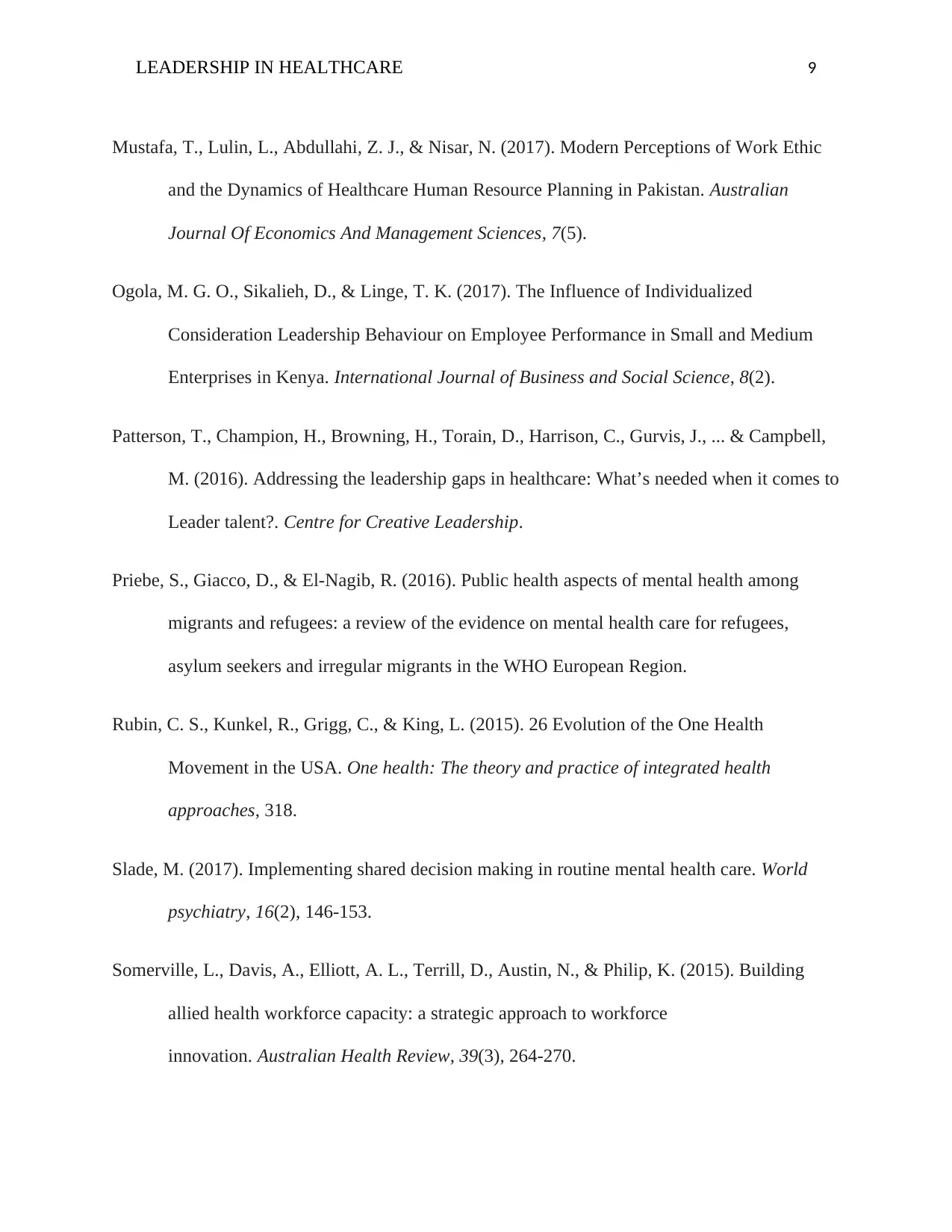
LEADERSHIP IN HEALTHCARE 9
Mustafa, T., Lulin, L., Abdullahi, Z. J., & Nisar, N. (2017). Modern Perceptions of Work Ethic
and the Dynamics of Healthcare Human Resource Planning in Pakistan. Australian
Journal Of Economics And Management Sciences, 7(5).
Ogola, M. G. O., Sikalieh, D., & Linge, T. K. (2017). The Influence of Individualized
Consideration Leadership Behaviour on Employee Performance in Small and Medium
Enterprises in Kenya. International Journal of Business and Social Science, 8(2).
Patterson, T., Champion, H., Browning, H., Torain, D., Harrison, C., Gurvis, J., ... & Campbell,
M. (2016). Addressing the leadership gaps in healthcare: What’s needed when it comes to
Leader talent?. Centre for Creative Leadership.
Priebe, S., Giacco, D., & El-Nagib, R. (2016). Public health aspects of mental health among
migrants and refugees: a review of the evidence on mental health care for refugees,
asylum seekers and irregular migrants in the WHO European Region.
Rubin, C. S., Kunkel, R., Grigg, C., & King, L. (2015). 26 Evolution of the One Health
Movement in the USA. One health: The theory and practice of integrated health
approaches, 318.
Slade, M. (2017). Implementing shared decision making in routine mental health care. World
psychiatry, 16(2), 146-153.
Somerville, L., Davis, A., Elliott, A. L., Terrill, D., Austin, N., & Philip, K. (2015). Building
allied health workforce capacity: a strategic approach to workforce
innovation. Australian Health Review, 39(3), 264-270.
Mustafa, T., Lulin, L., Abdullahi, Z. J., & Nisar, N. (2017). Modern Perceptions of Work Ethic
and the Dynamics of Healthcare Human Resource Planning in Pakistan. Australian
Journal Of Economics And Management Sciences, 7(5).
Ogola, M. G. O., Sikalieh, D., & Linge, T. K. (2017). The Influence of Individualized
Consideration Leadership Behaviour on Employee Performance in Small and Medium
Enterprises in Kenya. International Journal of Business and Social Science, 8(2).
Patterson, T., Champion, H., Browning, H., Torain, D., Harrison, C., Gurvis, J., ... & Campbell,
M. (2016). Addressing the leadership gaps in healthcare: What’s needed when it comes to
Leader talent?. Centre for Creative Leadership.
Priebe, S., Giacco, D., & El-Nagib, R. (2016). Public health aspects of mental health among
migrants and refugees: a review of the evidence on mental health care for refugees,
asylum seekers and irregular migrants in the WHO European Region.
Rubin, C. S., Kunkel, R., Grigg, C., & King, L. (2015). 26 Evolution of the One Health
Movement in the USA. One health: The theory and practice of integrated health
approaches, 318.
Slade, M. (2017). Implementing shared decision making in routine mental health care. World
psychiatry, 16(2), 146-153.
Somerville, L., Davis, A., Elliott, A. L., Terrill, D., Austin, N., & Philip, K. (2015). Building
allied health workforce capacity: a strategic approach to workforce
innovation. Australian Health Review, 39(3), 264-270.
⊘ This is a preview!⊘
Do you want full access?
Subscribe today to unlock all pages.

Trusted by 1+ million students worldwide
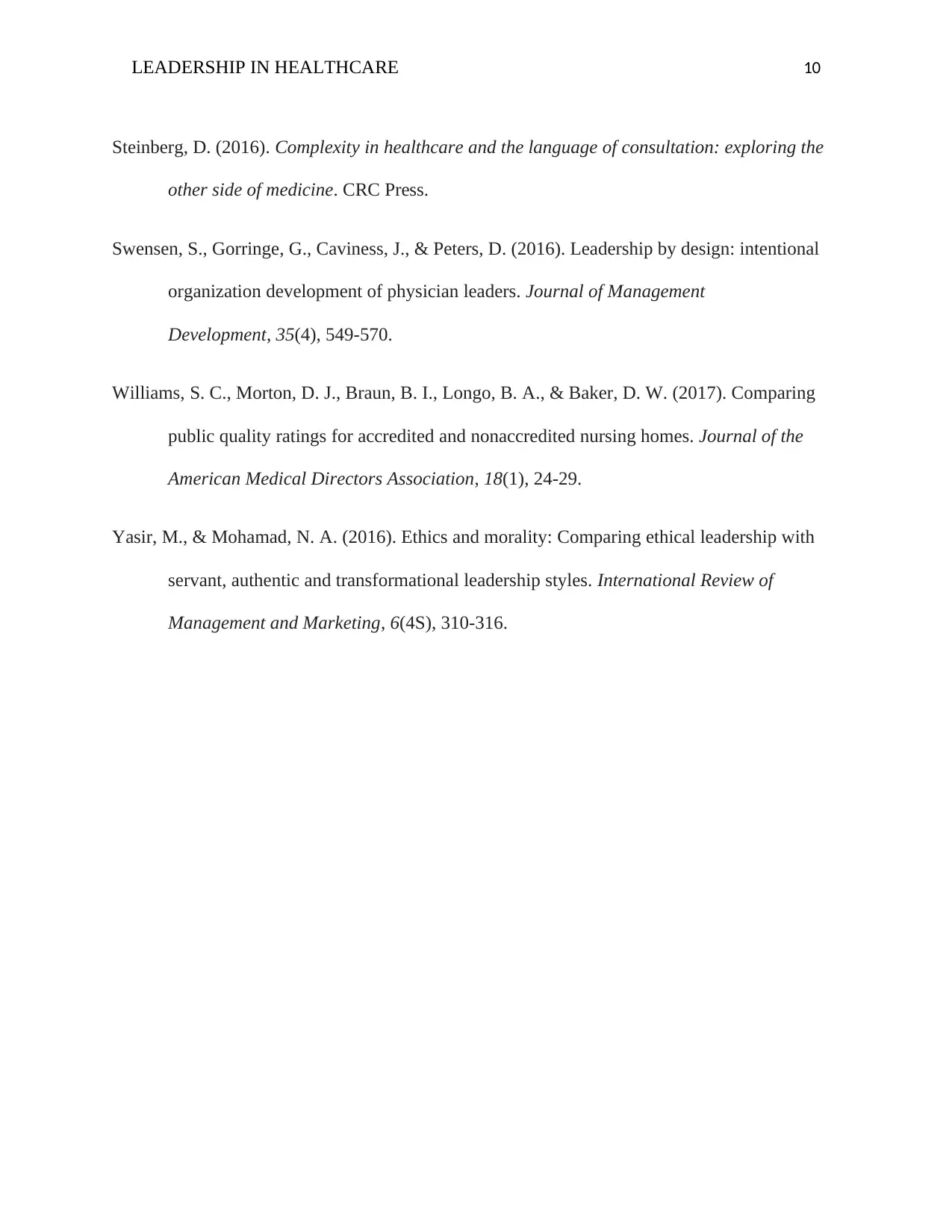
LEADERSHIP IN HEALTHCARE 10
Steinberg, D. (2016). Complexity in healthcare and the language of consultation: exploring the
other side of medicine. CRC Press.
Swensen, S., Gorringe, G., Caviness, J., & Peters, D. (2016). Leadership by design: intentional
organization development of physician leaders. Journal of Management
Development, 35(4), 549-570.
Williams, S. C., Morton, D. J., Braun, B. I., Longo, B. A., & Baker, D. W. (2017). Comparing
public quality ratings for accredited and nonaccredited nursing homes. Journal of the
American Medical Directors Association, 18(1), 24-29.
Yasir, M., & Mohamad, N. A. (2016). Ethics and morality: Comparing ethical leadership with
servant, authentic and transformational leadership styles. International Review of
Management and Marketing, 6(4S), 310-316.
Steinberg, D. (2016). Complexity in healthcare and the language of consultation: exploring the
other side of medicine. CRC Press.
Swensen, S., Gorringe, G., Caviness, J., & Peters, D. (2016). Leadership by design: intentional
organization development of physician leaders. Journal of Management
Development, 35(4), 549-570.
Williams, S. C., Morton, D. J., Braun, B. I., Longo, B. A., & Baker, D. W. (2017). Comparing
public quality ratings for accredited and nonaccredited nursing homes. Journal of the
American Medical Directors Association, 18(1), 24-29.
Yasir, M., & Mohamad, N. A. (2016). Ethics and morality: Comparing ethical leadership with
servant, authentic and transformational leadership styles. International Review of
Management and Marketing, 6(4S), 310-316.
1 out of 10
Related Documents
Your All-in-One AI-Powered Toolkit for Academic Success.
+13062052269
info@desklib.com
Available 24*7 on WhatsApp / Email
![[object Object]](/_next/static/media/star-bottom.7253800d.svg)
Unlock your academic potential
Copyright © 2020–2025 A2Z Services. All Rights Reserved. Developed and managed by ZUCOL.





